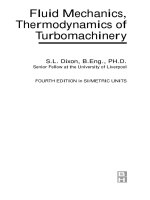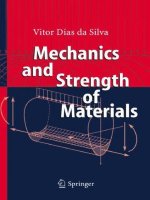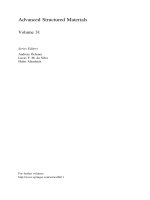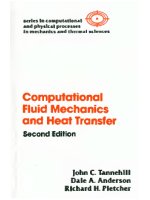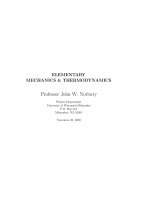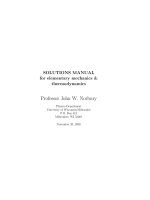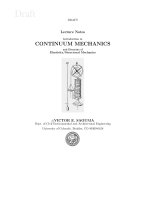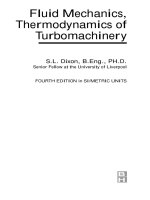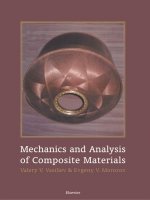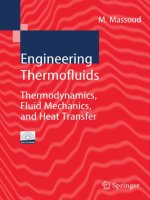dixon (1998) fluid mechanics and thermodynamics of turbomachinery 4th ed
Bạn đang xem bản rút gọn của tài liệu. Xem và tải ngay bản đầy đủ của tài liệu tại đây (13.92 MB, 333 trang )
Fluid Mechanics and
Thermodynamics
of
Turbomachinery
Fourth Edition, in WMetric units
S.
L.
Dixon, B.Eng., Ph.D
Senior Fellow at the University
of
Liverpool
1
EINEMANN
Boston
Oxford
Johannesburg
Melbourne New Delhi Singapore
Butterworth-Heinemann
&c
A member of the Reed Elsevier Group
First published by Pergamon Press Ltd. 1966
Second edition 1975
Third edition 1978
Reprinted 1979, 1982 (twice), 1984, 1989, 1992, 1995
Foruth edition 1998
0
S.
L. Dixon 1978, 1998
All rights reserved.
No
part of this publication may be reproduced, stored in a retrieval system,
or
transmitted in any form
or
by any means, electronic, mechanical, photo-
copying, recording,
or
otherwise, without the prior written permission of
the publisher.
Recognizing the importance of preserving what
has
been written, Butter-
@
worth-Heinemann prints its books on acid-free paper whenever possible.
Butterworth-Heinemann supports the efforts of American Forests
and the Global ReLeaf program in its campaign for the betterment
of trees, forests, and our environment.
L ,'
ra.,,,,
2ooo
Library
of
Congress Cataloging-in-Publication Data
A catalog record for this book
is
available from the Library of Congress
ISBN 0-7506-7059-2
British Library Cataloguing-in-Publication Data
A catalogue record for this book
is
available from the British Library
The publisher offers special discounts on bulk orders
of
this book.
For information, please contact:
Manager of Special Sales
Butterworth-Heinemann
225 Wildwood Avenue
Woburn,
MA
01801-2041
Tel: (781) 904-2500
Fa:
(781) 904-2620
For
information on all Butterworth-Heinemann publications available, contact our
World Wide Web home page at:
10 9876543
Printed in the United States of America
Typeset by Laser Words, Madras, India
Acknowledgements
The author is indebted to a number of people and manufacturing organisations for
their help and support; in particular the following are thanked:
Professor
W.
A.
Woods,
formerly of Queen
Mary
College, University of London
and a former colleague at the University of Liverpool for
his
encouragement of the
idea of a fourth edition of
this
book as well as providing papers and suggestions for
some new items to
be
included. Professor
F.
A. Lyman of Syracuse University, New
York and Professor
J.
Moore
of
Virginia Polytechc Institute and State University,
Virginia, for their helpful correspondence and ideas concerning the vexed question
of
the conservation of rothalpy in turbomachines. Dr Y. R. Mayhew is thanked for
supplying me with generous amounts of material on units and dimensions and the
latest state of play on SI Units.
Thanks
are also given to the following organisations for providing me with illus-
trative material for use in the book, product information and, in one case, useful
background historical information:
Sulzer Hydro of Zurich, Switzerland; Rolls-Royce of Derby, England; Voith
Hydro Inc., Pennsylvania; and Kvaerner Energy, Norway.
Last, but by
no
means least, to my wife Rose, whose quiet patience and support
enabled this new edition to be prepared.
List
of
Symbols
area
sonic velocity, position of maximum camber
passage width, maximum camber
tangential force coefficient
lift and drag coefficients
specific heat at constant pressure, pressure coefficient, pressure
rise
coefficient
ideal pressure rise coefficient
specific heat at constant volume
axial and tangential force coefficients
absolute velocity
spouting velocity
drag force, diameter
equivalent diffusion ratio
hydraulic mean diameter
energy, specific energy
centrifugal force in blade
acceleration, friction factor
gravitational acceleration
head, blade height
effective head
head loss fue to friction
gross
head
net positive suction head
(NPSH)
specific enthalpy
rothalpy
incidence angle
constants
nozzle velocity coefficient
lift force, length of diffuser wall
blade chord length, pipe length
Mach number
mass, molecular ‘weight’
rotational
speed,
axial length of diffuser
specific speed (rev)
power specific speed (rev)
suction specific speed (rev)
number of stages, polytropic index
pressure
List
of
Symbols
xv
Pa
Pv
4
R
Re
RH
Ro
r
S
T
t
U
v,
v
W
AW
X
x,
y.
z
Y
Q
S
U
W
Yid
yk
YP
YS
z
a!
B
r
Y
6
<
rl
0
A.
CL
P
E
e
v
0
ab
0,
T
atmospheric pressure
vapour pressure
heat transfer, volume flow rate
dryness fraction
reaction, specific gas constant
Reynolds number
reheat factor
universal gas constant
radius
entropy, power ratio
blade pitch, specific entropy
temperature
time, thickness
blade speed, internal energy
specific internal energy
volume, specific volume
work transfer
specific work transfer
relative velocity
axial force
Cartesian coordinate directions
tangential force, actual tangential blade load per unit span
ideal tangential blade load per unit span
tip clearance loss coefficient
profile loss coefficient
net secondary loss coefficient
number of blades, Ainley blade loading parameter
absolute flow angle
relative flow angle
circulation
ratio of specific heats
deviation angle
fluid deflection angle, cooling effectiveness
enthalpy loss coefficient, total pressure
loss
coefficient
efficiency
minimum opening at cascade exit
blade camber angle, wake momentum thickness
profile
loss
coefficient
dynamic viscosity
kinematic viscosity, blade stagger angle, velocity ratio
density
slip factor, solidity
blade cavitation coefficient
Thoma’s coefficient, centrifugal stress
torque
xvi
Fluid Mechanics, Thermodynamics
of
Turbomachinery
flow coefficient, velocity ratio
stage loading factor
speed
of
rotation (rads)
specific speed (rad)
power specific speed (rad)
suction specific speed (rad)
vorticity
stagnation pressure loss coefficient
Subscripts
av
D
e
h
i
id
is
m
N
n
P
R
r
re1
c
0
S
ss
t
x,
y,
z
21
e
average
compressor, critical
diffuser
exit
hydraulic, hub
inlet, impeller
ideal
isentropic
mean, meridional, mechanical, material
nozzle
normal component
stagnation property, overall
polytropic, constant pressure
reversible process, rotor
radial
relative
isentropic, stall condition
stage isentropic
turbine, tip, transverse
velocity
Cartesian coordinate components
tangential
Superscript
time rate
of
change
average
blade angle
(as
distinct from flow angle)
*
nominal condition
I
Preface
to Third Edition
Several modifications have been incorporated into the text in the light of recent
advances in some aspects of the subject. Further information on
the
interesting
phenomenon of cavitation has been included and a new section on the optimum
design of a pump inlet together with a worked example have been added which
take into account recently published data on cavitation limitations. The chapter on
three-dimensional
Jlows
in axial turbomachines
has been extended; in particular the
section concerning the
constant specijic mass
Jlow
design
of a turbine nozzle has
been clarified and now includes the flow equations for a following rotor row. Some
minor alterations on the definition of blade shapes were needed
so
I
have taken the
opportunity of including a simplified version of the parabolic arc camber line as
used for some low camber blading.
Despite careful proof reading a number of errors still managed to elude me in the
second edition. I am most grateful to those readers who have detected errors and
communicated with me about them.
In order to assist the reader
I
have (at last) added a list of symbols used in the
text.
S.L.D.
xi
Preface
to
the
Fourth
Edition
It is now twenty years since the third edition of this book was published and in
that period many advances have been made to the
art
and science of turboma-
chinery design. Knowledge of the flow processes within turbomachines has increased
dramatically resulting in the appearance of new and innovative designs. Some of
the long-standing, apparently intractable, problems such as surge and rotating stall
have begun to yield to new methods of control. New types of flow machine have
made their appearance (e.g. the Wells turbine and the axi-fuge compressor) and
some changes have been made to established design procedures. Much attention
is now being given to blade and flow passage design using computational fluid
dynamics
(CFD)
and this must eventually bring forth further design and flow effi-
ciency improvements. However, the fundamentals do not change and this book is
still concerned with the basics of the subject as well as looking at new ideas.
The book was originally perceived as a text for students taking an Honours degree
in engineering which included turbomachines as well as assisting those undertaking
more advanced postgraduate courses in the subject. The book was written for engi-
neers rather than mathematicians. Much stress is laid on physical concepts rather
than mathematics and the use of specialised mathematical techniques is mostly kept
to a minimum. The book should continue to be of use to engineers in industry
and technological establishments, especially as brief reviews are included on many
important aspects of turbomachinery giving pointers to more advanced sources of
information. For those loolung towards the wider reaches of the subject area some
interesting reading is contained in the bibliography. It might be of interest to know
that the third edition was published in four languages.
A fairly large number of additions and extensions have been included in the
book from the new material mentioned as well as “tidying up” various sections
no longer to my liking. Additions include some details of a new method of fan
blade design, the determination of the design point efficiency of a turbine stage,
sections on centrifugal stresses in turbine blades and blade cooling, control of flow
instabilities in axial-flow compressors, design of the Wells turbine, consideration of
rothalpy conservation in impellers (and rotors), defining and calculating the optimum
efficiency of inward flow turbines and comparison with the nominal design. A
number of extensions of existing topics have been included such as updating and
extending the treatment and application of diffuser research, effect of prerotation
of
the flow in centrifugal compressors and the use of backward swept vanes on
their performance, also changes in the design philosophy concerning the blading of
axial-flow compressors. The original chapter on radial flow turbines has been split
into two chapters; one dealing with radial gas turbines with some new extensions
and the other on hydraulic turbines. In a world striving for a ‘greener’ future it was
felt that there would now be more than just a little interest in hydraulic turbines. It
is a subject that is usually included in many mechanical engineering courses. This
chapter includes a few new ideas which could be
of
some interest.
x
Preface
to the
Fourth
Edition
A
large number
of
illustrative examples have been included in the text and many
new problems have been added at the end
of
most chapters (answers
are
given at the
end
of
the book)! It is planned to publish a new supplementary text called Solutions
Manual, hopefully, shortly after
this
present text
book
is due to appear, giving the
complete and detailed solutions
of
the unsolved problems.
S.
Lawrence Dixon
Contents
PREFACE
TO
FOURTH
EDITION ix
PREFACE
TO
THIRD
EDITION xi
ACKNOWLEDGEMENTS
xiii
LIST
OF
SYMBOLS
XiV
1.
Introduction: Dimensional Analysis:
Similitude
1
Definition of a turbomachine
I
Units
and
dimensions
3
Dimensional analysis and pegormance
laws
Incompressible jluid analysis
6
Performance characteristics
7
Variable geometry turbomachines
9
Specijc speed
10
Cavitation
12
Compressible
gas
flow relations 15
Compressible jluid analysis
16
The inherent unsteadiness of thejlow within turbomachines
References 21
Problems 22
4
20
2.
Basic Thermodynamics,
Fluid
Mechanics:
Definitions
of
Efficiency
23
Introduction 23
The equation of continuity 23
The first law of thermodynamics
-
internal energy
The momentum equation
-
Newton’s second law of motion
The second law of thermodynamics
-
entropy
Definitions of efficiency 30
Small stage
or
polytropic efficiency
Nozzle efficiency 41
Dimers 43
References
53
Problems 53
24
25
29
35
vi
Contents
3.
Two-dimensional Cascades
55
Introduction 55
Cascade nomenclature 56
Analysis of cascade forces 57
Energy losses 59
Lif anddrag
59
Circulation and
113
61
Efficiency of a compressor cascade
Performance of two-dimensional cascades 63
The cascade wind tunnel 63
Cascade test results 65
Compressor cascade performance 68
Turbine cascade performance
70
Compressor cascade correlations 71
Fan blade design (McKenzie)
80
Turbine cascade correlation (Ainley)
81
Comparison of the profile
loss
in a cascade and in a turbine stage
Optimum space-chord ratio of turbine blades (Zweifel)
References 88
Problems
90
62
86
87
4.
Axial-flow
Turbines:
Two-dimensional Theory
93
Introduction 93
Velocity diagrams of the axial turbine stage
Thermodynamics
of
the axial turbine stage
Stage losses and efficiency 96
Soderberg
's
correlation 97
Types of axial turbine design
Stage reaction
101
Diffusion within blade
rows
103
Choice
of
reaction
and
effect
on
efficiency
Design point efficiency
of
a turbine stage
Maximum total-to-static eflciency of a112 reversible turbine stage
Stresses in turbine
rotor
blades
Turbine flow characteristics I20
Flow characteristics of a multistage turbine
The Wells turbine 124
References 132
Problems 133
93
94
99
107
108
I14
122
5.
Axial-flow Compressors and
Fans
137
Introduction 137
Two-dimensional analysis of the compressor stage
Velocity diagrams of the compressor stage
Thermodynamics of the compressor stage
138
140
141
Contents
vii
Stage
loss
relationships and efficiency
Reaction ratio 143
Choice of reaction 143
Stage loading
I44
Simplified off-design petformance 145
Stage pressure rise 147
Pressure ratio
of
a multistage compressor
Estimation of compressor stage efficiency
Stall and surge phenomena in compressors
Control offlow instabilities
I59
Axial-flow ducted fans
160
Blade element theory 162
Blade element efficiency
163
Lifi coefficient of a fan aerofoil
References
I65
Problems
166
142
148
149
154
164
6.
Three-dimensional
Flows
in
Axial
Turbomachines
169
Introduction
I69
Theory of radial equilibrium 169
The indirect problem 171
The direct problem 179
Compressible$ow through afired blade row
Constant specific mass flow
181
Off-design performance of a stage
Free-vortex turbine stage
184
Actuator disc approach
186
Blade
row
interaction effects 190
Computer-aided methods
of
solving the through-flow problem
Secondaryj?ows
193
References
195
Problems
1%
180
183
191
7.
Centrifugal Pumps,
Fans
and Compressors
199
Introduction 199
Some definitions 200
Theoretical analysis
of
a centnfugal compressor
Inlet casing 203
Impeller 203
Conservation of rothalpy 204
Dimer 205
Inlet velocity limirations 205
Optimum design
of
a pump inlet
Optimum design of a centrifugal compressor inlet
Slip factor 213
Head increase of a centrifugal pump
202
206
208
218
viii
Contents
Performance of centrifugal compressors 219
The difiser system 227
Choking in a compressor stage
References 232
Problems 233
230
8.
Radial Flow
Gas
Turbines
2%
Introduction 236
Types of inwardflow radial turbine
Thermodynamics of the 90 deg IFR turbine
Basic design of the rotor
Nominal design point efficiency 242
Mach number relations 246
Loss
coefficients in 90 deg IFR turbines
Optimum efficiency considerations 248
Criterion for minimum number of blades
Design considerations for rotor exit
Incidence losses 260
SigniJicance and application of specific speed
Optimum
design selection of 90 deg IFR turbines
Clearance and windage losses 269
Pressure ratio limits of the
90
deg IFR turbine
Cooled 90 deg IFR turbines
References 272
Problems 273
237
239
241
247
253
256
263
266
269
271
9.
Hydraulic Turbines
277
Introduction 277
Hydraulic turbines 278
The Pelton turbine 281
Reaction turbines 290
The Francis turbine 290
The Kaplan turbine 296
Effect of size on turbomachine efficiency
Cavitation 301
References 305
Problems 306
299
Bibliography
309
Appendix
1.
Conversion
of
British and
US Units
to
SI
Units
310
Appendix
2.
Answers
to
Problems
311
Index
315
Introduction: Dimensional
Analysis: Similitude
If
you
have known one
you
have known all.
(TERENCE,
Phonnio.)
Definition of
a
turbomachine
We classify as turbomachines all those devices in which energy is transferred
either to, or from, a continuously flowing fluid by the
dynamic action
of one or
more moving blade rows. The word
turbo
or
turbinis
is of Latin origin and implies
that which spins or whirls around. Essentially, a rotating blade row, a
rotor
or an
impelZer
changes the stagnation enthalpy of the fluid moving through it by either
doing positive or negative work, depending upon the effect required of the machine.
These enthalpy changes are intimately linked with the pressure changes occumng
simulataneously in the fluid.
The definition of a turbomachine as stated above, is rather too general for the
purposes of this book as it embraces
open
turbomachines such as propellers, wind
turbines and unshrouded fans, all of which influence the state
of
a not readily
quantifiable flow of a fluid. The subject
fluid mechanics, thermodynamics
of
turbo-
machinery,
therefore, is limited to machines enclosed by a closely fitting casing or
shroud through which a readily measurable quantity
of
fluid passes in unit time.
The subject of open turbomachines is covered by the classic text of Glauert (1959)
or by Duncan
et
al.
(1970), the elementary treatment of propellers by general fluid
mechanics textbooks such as Streeter and Wylie (1979) or Massey (1979), and the
important, still developing subject of wind turbines, by Freris (1990).
Two main categories of turbomachine are identified: firstly, those which
absorb
power to increase the fluid pressure or head (ducted fans, compressors and pumps);
secondly, those that
produce
power by expanding fluid to a lower pressure or head
(hydraulic, steam and gas turbines). Figure 1.1 shows, in a simple diagrammatic
form, a selection
of
the many different varieties of turbomachine encountered in
practice. The reason that
so
many different types of either pump (compressor) or
turbine are in use is because of the almost infinite range of service requirements.
Generally speaking, for a given set of operating requirements there is one type of
pump or turbine best suited to provide optimum conditions of operation. This point
is discussed more fully in the section of this chapter concerned with specific speed.
Turbomachines
are
further categorised according to the nature of the flow path
through the passages of the rotor. When the path
of
the
through-flow
is wholly or mainly
parallel
to
the axis of rotation, the device is termed an
axialflow turbomachine
(e.g.
1
2
Fluid Mechanics, Thermodynamics
of
Turbomachinery
FIG.
1
.l.
Diagrammatic
form
of
various types
of
turbomachine.
Figure l.l(a) and (e)). When the path of the
through-jow
is wholly or mainly in a plane
perpendicular to the rotation axis, the device is termed a
radialflow turbomachine
(e.g.
Figure 1. l(c)). More detailed sketches
of
radial flow machines are given in Figures 7.1,
7.2, 8.2
and
8.3.
Mixedpow turbomachines
are widely used. The term
mixedjow
in
this context refers to the direction of the through-flow at rotor outlet when both radial
and axial velocity components are present in significant amounts. Figure 1.1 (b) shows
a mixed flow pump and Figure 1.1 (d) a mixed flow hydraulic turbine.
One further category should be mentioned. All turbomachines can be classified
as either
impulse
or
reaction
machines according to whether pressure changes are
Introduction: Dimensional Analysis: Similitude
3
absent or present respectively in the flow through the rotor. In an impulse machine
all the pressure change takes place in one or more nozzles, the fluid being directed
onto the rotor. The Pelton wheel, Figure 1.1
(f),
is an example of an impulse turbine.
The main purpose of this book is to examine, through the laws of fluid mechanics
and thermodynamics, the means by which
the
energy transfer is achieved in the
chief types of turbomachine, together with the differing behaviour of individual
types in operation. Methods of analysing the flow processes differ depending upon
the geometrical configuration of the machine, on whether the fluid can be regarded
as incompressible or not, and whether the machine absorbs or produces work. As
far as possible, a unified treatment is adopted
so
that machines having similar
configurations and function are considered together.
Units and dimensions
The International System of Units, SI (le Systkme International d'UnitCs)
is a unified self-consistent system of measurement units based on the MKS
(metre-kilogram-second) system. It is a simple, logical system based upon decimal
relationships between units making it easy to use. The most recent detailed
description of SI has been published in 1986 by
Hh4SO.
For an explanation of
the relationshlp between, and use of, physical quantities, units and numerical values
see
Quantities, Units and
Symbols,
published by The Royal Society (1975) or refer
Great Britain was the first of the English-speaking countries to begin, in the
1960s, the long process of abandoning the old Imperial System of Units in favour
of the International System of Units, and was soon followed by Canada, Australia,
New Zealand and South Africa. In the USA a ten year voluntary plan of conversion
to SI units was commenced in 1971. In 1975 US President Ford signed the Metric
Conversion Act which coordinated the metrication of units, but did
so
without
specifying
a
schedule of conversion. Industries heavily involved in international
trade (cars, aircraft, food and drink) have, however, been quick to change to
SI
for
obvious economic reasons, but others have been reluctant to change.
SI
has now become established as the only system of units used for teaching
engineering in colleges, schools and universities in most industrialised countries
throughout the world. The Imperial System was derived arbitrarily and has no
consistent numerical base, making it confusing 'and difficult to learn. In this book
all numerical problems involving units
are
performed in metric units as
this
is more
convenient than attempting to use a mixture of the two systems. However, it is
recognised that some problems exist as a result of the conversion to SI units. One
of these is that many valuable papers and texts written prior to 1969 contain data
in the old system of units and would need converting to SI units. A brief
summary
of the conversion factors between the more frequently used Imperial units and SI
units is given in Appendix 1 of this book.
Some
SI
units
to IS0 31/0-1981.
The
SI
basic units used in fluid mechanics and thermodynamics are the
metre
(m),
kilogram
(kg), second
(s)
and
thermodynamic temperature
(K).
All
the
other
units used in this book are derived from these basic units. The
unit offorce
is the
4
Fluid Mechanics, Thermodynamics
of
Turbomachinery
newton
(N), defined as that force which, when applied to a mass of lkilogram,
gives an acceleration to the mass of 1
m/s2.
The recommended
unit
of
pressure
is
the
pascal
(Pa) which is the pressure produced by a force of 1 newton uniformly
distributed over an area of 1 square metre. Several other units of pressure are in wide-
spread use, however, foremost of these being the
bar.
Much basic data concerning
properties of substances (steam and gas tables, charts, etc.) have been prepared in SI
units with pressure given in bars and it is acknowledged that
this alternative unit of
pressure will continue to
be
used for some time as a matter of expediency. It is noted
that 1 bar equals
Id
Pa (i.e.
1d
N/m2), roughly the pressure of the atmosphere at
sea level, and is perhaps an inconveniently large unit for pressure in the field of
turbomachinery anyway! In this book the convenient size of the
kilopascal
(kPa) is
found to be the most useful multiple of the recommended unit and is extensively
used in most calculations and examples.
In SI the units of all forms of energy are the same as for work. The
unit
of
energy
is the
joule
(J) which is the work done when a force of 1 newton is displaced through
a distance of 1 metre in the direction of the force, e.g. kinetic energy
(
imc2)
has the
dimensions kg
x
m2/s2; however, 1 kg
=
1 N s2/m from the definition of the newton
given above. Hence, the units of kinetic energy must
be
Nm
=
J upon substituting
dimensions.
The
watt
(W)
is the
unit
of
power;
when 1 watt is applied for 1 second to a system
the input of energy to that system is 1 joule (Le. 1 J).
The
hertz
(Hz) is the number of repetitions of a regular Occurrence in 1 second.
Instead of writing c/s for cycles/sec,
Hz
is used instead.
The unit
of
thermodynamic temperature
is the
kelvin
(K),
written without the
sign, and is the fraction U273.16 of the thermodynamic temperature of the triple
point of water. The degree Celsius ("C) is equal to the unit kelvin. Zero on
the
Celsius scale is the temperature of the ice point (273.15
K).
Specific heat capacity,
or simply specific heat, is expressed as J/kg
K
or as J/kg"C.
Dynamic viscosity, dimensions
ML-'
T-'
,
has the
SI
units of pascal seconds, i.e.
M
kg
N.s2
LT
m.s m.2s
-
=Pas.
- -
Hydraulic engineers find it convenient to express pressure in terms of
head
of a
liquid. The static pressure at any point in a liquid at rest is, relative to
the
pressure
acting on the free surface, proportional to the vertical distance of the free surface
above that point. The head
H
is simply the height of a column of the liquid which
can
be
supported by this pressure. If
p
is the mass density (kg/m3) and
g
the local
gravitational acceleration
(m/s2),
then the static pressure
p
(relative to atmospheric
pressure) is
p
=
pgH,
where
H
is in metres and
p
is in pascals (or N/m2).
This
is
left for the student to verify as a simple exercise.
Dimensional analysis and performance laws
The widest comprehension of the general behaviour of all turbomachines
is,
without doubt, obtained from
dimensional analysis.
This is the formal procedure
whereby the group of variables representing some physical situation is reduced
Introduction: Dimensional Analysis: Similitude
5
into a smaller number of dimensionless groups. When the number of indepen-
dent variables is not too great, dimensional analysis enables experimental relations
between variables to be found with the greatest economy of effort. Dimensional
analysis applied to turbomachines has two further important uses: (a) prediction
of
a prototype’s performance from tests conducted on a scale model (similitude);
(b) determination of the most suitable type of machme, on the basis of maximum
efficiency, for a specified range of head, speed and flow rate. Several methods of
constructing non-dimensional groups have been described by Douglas
et
al.
(1995)
and by Shames
(1992)
among other authors. The subject of dimensional analysis was
made simple and much more interesting by Edward Taylor
(1974)
in his comprehen-
sive account of the subject. It is assumed here that the basic techniques of forming
non-dimensional groups have already been acquired by the student.
Adopting the simple approach
of
elementary thermodynamics, an imaginary enve-
lope (called a
control surjiace)
of fixed shape, position and orientation is drawn
around the turbomachine (Figure
1.2). Across this boundary, fluid flows steadily,
entering at station
1
and leaving at station
2.
As
well as the flow of fluid there
is a flow of work across the control surface, transmitted by the shaft either to, or
from, the machine. For the present all details of the flow within the machine can
be
ignored and only externally observed features such as shaft speed, flow rate,
torque and change in fluid properties across the machine need be considered.
To
be
specific, let the turbomachine be a
pump
(although the analysis could apply to other
classes of turbomachine) driven by an electric motor. The speed of rotation
N,
can
be
adjusted by altering the current to the motor; the volume flow rate
Q,
can be
independently
adjusted by means of a throttle valve. For fixed values of the set
Q
and
N,
all other variables such as torque
t,
head
H,
are thereby established. The
choice of
Q
and
N
as
control variables
is clearly arbitrary and any other pair of
independent variables such as
t
and
H
could equally well have been chosen. The
important point to recognise is, that there are for this pump,
NO
control variables.
If the fluid flowing is changed for another of different density
p,
and viscosity
p,
the performance of the machine will be affected. Note, also, that for
a
turbo-
machine handling compressible fluids, other
Juid properties
are important and are
discussed later.
So
far we have considered only one particular turbomachine, namely a pump of
a given size.
To
extend the range of this discussion, the effect of the
geometric
FIG.
1.2.
Turbomachine considered as a control volume.
6
Fluid Mechanics, Thermodynamics
of
Turbomachinery
variables
on
the performance must now
be
included. The size of machine is char-
acterised by the impeller diameter D, and the shape can
be
expressed by a number
of length ratios,
l,/D, 12/D, etc.
Incompressible
fluid
analysis
The performance of a turbomachine can now
be
expressed in terms of the control
variables, geometric variables and fluid properties.
For
the hydraulic pump it is
convenient to regard the net energy transfer
gH,
the efficiency
q,
and power supplied
P,
as
dependent variables and to write the three functional relationships as
(1.la)
(l.lb)
(1.lc)
By the procedure of dimensional analysis using the three primary dimensions, mass,
length and time, or alternatively, using three of the independent variables we can
form the dimensionless groups. The latter, more direct procedure, requires that the
variables selected,
p,
N,
D, do not of themselves form a dimensionless group. The
selection of
p,
N,
D as common factors avoids the appearance of special fluid terms
(e.g.
p,
Q) in more than one group and allows
gH,
q
and
P
to
be
made explicit.
Hence the three relationships reduce to the following easily verified forms.
Energy transfer coefficient, sometimes called head coefficient
Power coefficient
(1.2a)
(1.2b)
(1.2c)
The non-dimensional group
Q/(ND3) is a volumetric flow coefficient and
pN@/p is a form of Reynolds number, Re.
In
axial flow turbomachines, an
alternative to
Q/(ND3) which is frequently used is the velocity (or flow) coefficient
4
=
c,/U
where
U
is blade tip speed and c, the average axial velocity. Since
Q
=
c,
x
flow area
cc
c,D2
and UccND.
then
Q
cx
ND3
U
-
cc
Introduction: Dimensional Analysis: Similitude
7
Because of the large number of independent groups of variables on the right-hand
side of eqns. (1.2), those relationships are virtually worthless unless certain terms
can be discarded.
In
a family of
geometrically similar
machines
ll/D, 12/D
are
constant and may be eliminated forthwith. The kinematic viscosity,
u
=
p/p
is
very small
in
turbomachines handling water and, although speed, expressed by
ND,
is low the Reynolds number is correspondingly high. Experiments confirm that
effects of Reynolds number on the performance are small and may be ignored in a
first approximation. The functional relationships for geometrically similar hydraulic
turbomachines are then,
(1.3a)
(1.3b)
(1.3~)
This is as
far
as the reasoning of dimensional analysis alone can be taken; the actual
fomz
of the functions f4,
f5
and
f6
must
be
ascertained by experiment.
One relation between
@,
4,
q
and
k
may
be
immediately stated.
For
a pump the
net hydraulic power,
PN
equals
pQgH
which is the minimum shaft power required
in the absence of all losses.
No
real process of power conversion is free of losses and
the actual shaft power
P
must be larger than
PN.
We define pump efficiency (more
precise definitions of efficiency are stated in Chapter
2)
q
=
PN/P
=
pQgH/P.
Therefore
Thus
f6
may be derived from
f4
and
fs
since
k
=
@@/q.
For a turbine the net
hydraulic power
PN
supplied is greater than the actual shaft power delivered by
the machine and the efficiency
q
=
P/PN.
This can be rewritten as
k
=
q@@
by
reasoning similar to the above considerations.
Performance characteristics
The operating condition of a turbomachine will be
dynamically similar
at two
different rotational speeds if all fluid velocities at
corresponding points
within the
machine are in
the
same direction and proportional to the blade speed. If two
points, one
on
each of two different head-flow characteristics, represent dynamically
similar operation of the machine, then the non-dimensional groups of the variables
involved, ignoring Reynolds number effects, may
be
expected to have the same
numerical value for both points. On
this
basis, non-dimensional presentation of
performance data has the important practical advantage of collapsing into virtually
a single curve, results that would otherwise require a multiplicity of curves if plotted
dimensionally
.
Evidence in support of the foregoing assertion is provided in Figure
1.3
which
shows experimental results obtained by the author (at the University of Liverpool)
on a simple centrifugal laboratory pump. Within the normal operating range of
this pump,
0.03
<
Q/(ND3)
<
0.06,
very little systematic scatter is apparent which
8
Fluid
Mechanics, Thennodynamics
of
Turbomachinery
might
be
associated with a Reynolds number effect, for the range of speeds
2500
5
N
5
5000revhin. For smaller flows,
Q/(ND3)
<
0.025,
the flow became unsteady
and the manometer readings of uncertain accuracy but, nevertheless, dynamically
similar conditions still appear to hold true. Examining the results at high flow rates
one is struck by a marked systematic deviation away from the “single-curve’’ law
at increasing speed.
This effect is due to
cavitation,
a high speed phenomenon of
hydraulic machines caused by the release of vapour bubbles at low pressures, which
is
discussed later in this chapter. It will
be
clear at this stage that under cavitating
flow conditions, dynamical similarity is not possible.
FIG.
1.3.
Dimensionless head-volume characteristic of a centrifugal pump.
FIG.
1.4.
Extrapolation of characteristic curves for dynamically similar conditions at
N
=
3500
rev/min.
Introduction: Dimensional Analysis: Similitude
9
The non-dimensional results shown in Figure 1.3 have, of course, been obtained
for a particular pump. They would also be approximately valid for a range
of
different
pump sizes
so
long as all these pumps are geometrically similar and cavi-
tation is absent. Thus, neglecting any change in performance due to change in
Reynolds number, the dynamically similar results in Figure 1.3 can be applied to
predicting the dimensional performance of a given pump
for
a series of required
speeds. Figure
1.4
shows such a dimensional presentation. It will
be
clear from the
above discussion that the locus of dynamically similar points in the
H-Q
field lies
on a parabola since
H
varies as
N2
and
Q
varies as
N.
Variable geometry turbomachines
The efficiency
of
a fixed geometry machine, ignoring Reynolds number effects,
is a unique function of flow coefficient. Such a dependence is shown by line (b)
in Figure 1.5. Clearly, off-design operation
of
such a machine is grossly inefficient
and designers sometimes resort to a
variable
geometry
machine in order to obtain
a better match with changing flow conditions. Figure 1.6 shows a sectional sketch
of
a mixed-flow pump in which the impeller vane angles may
be
varied
during
pump operation.
(A
similar arrangement is used in Kaplan turbines, Figure 1.1.)
Movement of the vanes
is
implemented by cams driven from a servomotor. In some
very large installations involving many thousands of kilowatts and where operating
FIG.
1.5.
Different efficiency curves for a given machine obtained with various blade
settings.
FIG.
1.6.
Mixed-flow pump incorporating mechanism for adjusting blade setting.
1
0
Fluid
Mechanics, Thermodynamics
of
Turbomachinery
conditions fluctuate, sophisticated systems of control may incorporate an electronic
computer.
The lines (a) and (c) in Figure 1.5 show the efficiency curves at other blade
settings. Each of these curves represents, in a sense, a different constant geometry
machine. For such a variable geometry pump the desired operating line intersects
the points of maximum efficiency of each of these curves.
Introducing the additional variable
B
into eqn. (1.3) to represent the setting of the
vanes, we can write
(1
5)
Alternatively, with
B
=
f3(4,
q)
=
f4(4,
II.),
B
can be eliminated to give a new
functional dependence
II.
=
fl(4,
B);
q
=
f2(47
B).
Thus, efficiency in a variable geometry pump is a function of both flow coefficient
and energy transfer coefficient.
Specific
speed
The pump or hydraulic turbine designer is often faced with the basic problem
of deciding what type of turbomachine will be the best choice for a given duty.
Usually the designer will
be
provided with some preliminary design data such as
the head
H,
the volume flow rate
Q
and the rotational speed
N
when a pump design
is under consideration. When a turbine preliminary design is being considered the
parameters normally specified are the shaft power P, the head at turbine entry
H
and the rotational speed
N.
A non-dimensional parameter called the spec$c speed,
N,,
referred to and conceptualised as the shape number, is often used to facilitate
the choice of the most appropriate machne. This new parameter is derived from the
non-dimensional groups defined in eqn.
(1.3)
in such a way that the characteristic
diameter
D
of the turbomachine is eliminated. The value of
N,
gives the designer
a guide to the type of machine that will provide the normal requirement of high
efficiency at the design condition.
For any one hydraulic turbomachine
with fired geometry there is a unique rela-
tionship between efficiency and flow coefficient if Reynolds number effects are
negligible and cavitation absent. As is suggested by any one of the curves in
Figure 1.5, the efficiency rises to a maximum value as the flow coefficient is
increased and then gradually falls with further increase in
6.
This optimum
effi-
ciency
q
=
qmax,
is used to identify a unique value
6
=
$1
and corresponding unique
values of
II.
=
1/11
and
?
=
?I.
Thus,
-
41
=
constant,
Q
ND3
-
1/11
=
constant,
gH
N2D2
(1.7a)
(1.7b)
(1.7~)
P
pN3 D5
-
P1
=
constant.
Introduction: Dimensional Analysis: Similitude
1
1
It is a simple matter to combine any pair of these expressions in such a way as to
eliminate
the
diameter. For a pump the customary way of eliminating
D
is to divide
@;I2
by
$;I4.
Thus
where
N,
is called the
speciJic speed.
The term specific speed is justified to the
extent that
N,
is directly proportional to
N.
In the case of a turbine the
power
speciJic speed
N,,,
is more useful and is defined by,
Both eqns. (1.8) and (1.9) are
dimensionless.
It is always safer and less confusing
to calculate specific speed in one or other of these forms rather than dropping the
factors
g
and
p
which would make the equations
dimensional
and any values of
specific speed obtained using them would then depend upon the choice of the units
employed. The dimensionless form
of
N,
(and
Nsp)
is the only one used in
this
book. Another point arises from the fact that the rotational speed,
N,
is expressed
in the units
of
revolutions per unit of time
so
that although
N,
is dimensionless,
numerical values of specific speed need to
be
thought of as revs. Alternative versions
of eqns. (1.8) and (1.9) in radians are also in common use and
are
written
Qrn
Q,,
=
~
(gH)5/4
’
(1.8a)
(1.9a)
There is a simple connection between
N,
and
N,,
(and between
52,
and Q,p). By
dividing eqn. (1.9) by eqn. (1.8) we obtain
From
the
definition of hydraulic efficiency, for a pump we obtain:
Nsp
Qsp 1
Ns
Q,
Jv’
-
-
and, for a turbine we obtain:
(1.9b)
(1.9~)
Remembering that specific speed, as defined above, is at the point
of
maximum
efficiency of a turbomachine, it becomes a parameter of great importance in selecting
the type
of
machine required for a given duty. The maximum efficiency condition
replaces
the condition of geometric similarity,
so
that any alteration in specific
12
Fluid Mechanics, Thermodynamics
of
Turbomachinery
FIG.
1.7.
Range
of
pump impellers
of
equal inlet area.
speed implies that the machine design changes. Broadly speaking, each different
class of machine has its optimum efficiency within its own fairly narrow range of
specific speed.
For a pump, eqn.
(1.8)
indicates, for constant speed
N,
that
N,
is increased by an
increase in
Q
and decreased by an increase in
H.
From eqn. (1.7b) it is observed
that
H,
at a constant speed
N,
increased with impeller diameter
D.
Consequently,
to increase
N,
the entry area must be made large and/or the maximum impeller
diameter small. Figure 1.7 shows a range of pump impellers varying from the axial-
flow type, through mixed flow to a centrifugal- or radial-flow type. The size of
each inlet is such that they all handle the same volume flow
Q.
Likewise, the head
developed by each impeller (of different diameter
D)
is made equal by adjusting
the speed of rotation
N.
Since
Q
and
H
are constant, then
N,
varies with
N
alone.
The most noticeable feature of this comparison is the large change in size with
specific speed. Since a higher specific speed implies a smaller machine, for reasons
of economy, it is desirable to select the
highest
possible
specific
speed
consistent
with
good
efficiency.
Cavitation
In selecting a hydraulic turbomachine for a given head
H
and capacity
Q,
it is
clear from the definition of specific speed, eqn.
(1
A),
that the highest possible value
of
N,
should be chosen because of the resulting reduction in size, weight and cost.
On this basis a turbomachine could be made extremely small were it not for the
corresponding increase in the fluid velocities. For machines handling liquids the
lower limit of size is dictated by the phenomenon of
cavitation.
Cavitation is the boiling of a liquid at normal temperature when the static pres-
sure is made sufficiently low. It may occur at the entry to pumps or at the exit
from hydraulic turbines in the vicinity of the moving blades. The dynamic action
of the blades causes the static pressure to reduce locally in a region which is
already normally
below atmospheric pressure and cavitation can commence. The
phenomenon is accentuated by the presence of dissolved gases which are released
with a reduction in pressure.
For the purpose of illustration consider a centrifugal pump operating at constant
speed and capacity. By steadily reducing the inlet pressure head a point is reached
